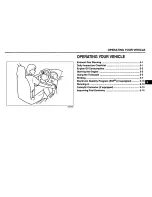
Cadillac Escalade Owner Manual (GMNA-Localizing-U.S./Canada/Mexico-
15567102) - 2022 - CRC - 8/16/21
414
VEHICLE CARE
Common causes for high trailer tire
temperature are underinflation,
overloading, or tire damage.
TTPMS Malfunction Message
The TTPMS will not function properly
if one or more of the trailer tire
sensors are missing or inoperable.
If the system detects a malfunction, a
DIC message indicates that the system
requires service. Some of the
conditions that can cause the service
message to occur are:
.
One of the trailer tires has been
replaced with the spare tire which
does not have a learned TTPMS
sensor. The DIC message should
turn off after the pressure sensor is
installed in the tire, and the
learning process is performed
successfully. See "TTPMS Sensor
Learning Process" under
.
The TTPMS sensor learning process
was not done or not completed
successfully. The DIC message
should go off after successfully
completing the sensor learning
process. See "TTPMS Sensor
Learning Process" under
.
.
One or more TTPMS sensors are
missing or damaged. The DIC
message should go off when the
TTPMS sensors are installed and
the sensor learning process is
performed successfully. See "TTPMS
Sensor Learning Process" under
.
.
Operating electronic devices or
being near facilities using radio
wave frequencies similar to the
TTPMS could cause interference to
the TTPMS which could cause loss
of signal reception from the sensor.
.
If the system does not receive the
signal from an individual sensor, an
error message may not occur until
the vehicle has been driver for a
period of time.
If the TTPMS is not functioning
properly, it cannot detect or signal a
low tire condition. See your dealer for
service if the DIC message comes on
and stays on when the trailer tire
pressures have been checked and
determined to be correct.
Tire Inspection
We recommend that the tires,
including the spare tire, if the
vehicle has one, be inspected for
signs of wear or damage at least
once a month.
Replace the tire if:
.
The indicators at three or more
places around the tire can
be seen.
.
There is cord or fabric showing
through the tire's rubber.
.
The tread or sidewall is cracked,
cut, or snagged deep enough to
show cord or fabric.
.
The tire has a bump, bulge,
or split.
.
The tire has a puncture, cut,
or other damage that cannot be
repaired well because of the size
or location of the damage.
















































